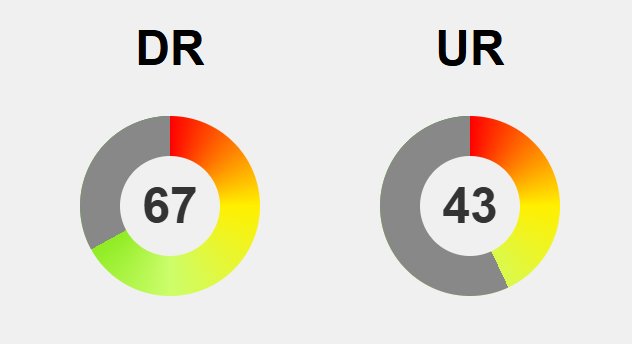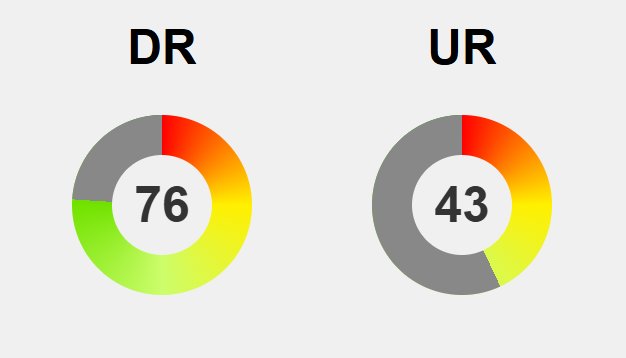Has your Domain Rating suddenly plummeted? Many website owners are witnessing sharp declines following Ahrefs’ major recalibration of their DR algorithm, which now emphasizes backlink quality, trust, and relevance over sheer volume. This isn’t a penalty—it’s a clearer, more honest reflection of true authority. But what does this mean for your SEO strategy? Fluctuations may reveal that superficial link-building tactics no longer suffice; instead, building genuine, high-quality backlinks is crucial. Should you panic or see this as an opportunity? The update encourages a strategic shift: audit your backlinks, disavow spam, and focus on earning authoritative links from reputable sources. By prioritizing valuable content and authentic relationships, you can stabilize and strengthen your backlink profile—aligning with evolving search engine standards. In an SEO landscape that rewards integrity, are you ready to adapt and build sustainable online authority?

Understanding Domain Rating: The New Era of Backlink Authority
Domain Rating, or DR, is a key metric that SEO professionals and website owners use to gauge their site’s authority. Created by Ahrefs, it offers a snapshot of how strong a website’s backlink profile is, giving insight into its online influence. Think of DR as a way to see how trustworthy or authoritative your site appears based on the quality and number of links pointing to it. The score ranges from 0 to 100, with higher numbers typically associated with well-established, reputable sites. While it’s not a direct ranking factor for Google, DR serves as a useful benchmark for comparing your site to competitors and spotting growth opportunities.
Recently, Ahrefs rolled out a significant update to how DR scores are calculated. This wasn’t a mere tweak but a major recalibration aimed at making the metric more accurate and reflective of actual backlink quality. Instead of simply counting links or focusing on their volume, the new system evaluates backlinks based on trust signals, relevance, and strength. This shift means that scores now better mirror real online influence, emphasizing the importance of link quality over sheer quantity. Many websites have noticed their DR scores fluctuating—some dropping, others rising—highlighting the impact of this refined approach.
This update isn’t about penalizing sites or rewarding others unfairly. Instead, it’s about providing a clearer, more honest picture of a site’s true authority. Previously, sites with many low-quality links might have appeared more influential than they really were. Now, with the new evaluation criteria, superficial link-building tactics are less effective in boosting scores. The focus is on earning high-quality, relevant backlinks from trustworthy sources, encouraging a more sustainable approach to SEO. This realignment nudges everyone toward building genuine authority rather than inflating metrics artificially.
Understanding what changed helps site owners interpret recent fluctuations. If your DR suddenly dipped, it’s likely a reflection of the new scoring model’s more precise evaluation rather than a penalty or a decline in your actual influence. This update filters out the noise created by low-quality links, offering a more accurate assessment of your backlink profile. Sites that relied on volume without regard for relevance or trustworthiness might see their scores dip, while those focusing on quality may stay stable or even improve. Recognizing this shift allows for a more strategic response, emphasizing authentic, valuable backlinks.
The recalibration aligns with broader industry trends, as search engines like Google increasingly prioritize signals such as trust, relevance, and authority. This means superficial link schemes or manipulative tactics are less effective under the new model. Instead, building relationships with reputable sites and creating content that naturally attracts links become essential. This focus not only improves your DR but also supports long-term visibility and credibility online. It’s a reminder that sustainable SEO is rooted in quality, not shortcuts.
For website owners, the key takeaway is to see these fluctuations not as setbacks but as an opportunity. The new DR model aims to reflect genuine influence more accurately, so use this moment to audit your backlink profile, disavow spammy links, and focus on earning high-quality backlinks from relevant, authoritative sources. Creating valuable, shareable content remains a cornerstone—think comprehensive guides, original research, or engaging visuals. Combined with strategic outreach, these efforts will help your DR stabilize and grow, aligning your backlink profile with the evolving standards of search engine algorithms and positioning your site for long-term success.

Expert Insights: Navigating DR Fluctuations and What They Mean
Many SEO professionals view Ahrefs’ recent DR recalibration as a step toward more trustworthy and precise backlink metrics. Instead of seeing the fluctuations as setbacks, they suggest viewing them as a valuable opportunity to reassess and refine your backlink profile. When your DR drops suddenly, it’s less about penalties and more about the new model’s effort to reflect genuine authority more accurately. Experts recommend analyzing how your backlink landscape has shifted—what links have been revalued, which ones have gained or lost importance—to guide your next strategic moves.
Building on this, seasoned SEO consultants emphasize the importance of ongoing backlink audits. Regularly reviewing your backlink profile with tools like Ahrefs helps uncover which links have gained or lost value and identify new opportunities for growth. For example, if high-authority, niche-relevant links have been reassessed or removed, it’s a signal to pursue fresh links through guest posting, outreach, or creating content that naturally attracts backlinks. Consistent management of your backlink profile is essential for maintaining or improving your DR over time.
A common theme among industry experts is the focus on quality over quantity. The update’s emphasis on trust signals, relevance, and link strength aligns with Google’s E-E-A-T principles. Sites that relied heavily on low-quality or manipulative link schemes may see their scores dip, but this is ultimately a positive shift. It encourages adopting cleaner, more ethical SEO practices that build real authority. Earning high-quality, niche-relevant backlinks from reputable sources not only stabilizes your DR but also supports sustainable long-term growth.
Many industry voices highlight that the fluctuations from this update mirror broader shifts in search engine algorithms. Google increasingly prioritizes trustworthiness and relevance, and the new DR model better aligns with these signals. For site owners, this means superficial link-building tactics will become less effective in the long run. Instead, investing in valuable content and fostering authentic relationships with reputable sites are the strategies that will hold up under future updates, ensuring your backlink profile remains resilient and meaningful.
Finally, some experts caution against reacting emotionally to these changes. A sudden drop in DR often triggers fears of penalties or ranking declines, but it’s crucial to see these fluctuations as part of a more precise evaluation process. The new model filters out low-quality links and adjusts scores to better reflect real influence. This perspective encourages a shift from panic to strategic action—conducting backlink audits, disavowing spammy links, and earning high-quality backlinks. Over time, these efforts will stabilize your DR and position your site for sustained SEO success.

Next Steps After the DR Update: Building a Resilient, High-Quality Backlink Profile
After a significant DR update, it’s natural to feel uncertain about what the fluctuations in your score really mean for your website. But these changes are often just part of a broader recalibration process rather than signals of penalties or declining rankings. Instead of reacting with panic, take a moment to step back and assess your backlink profile with a clear eye. Focus on strengthening what truly matters—building a solid foundation rooted in quality, relevance, and trustworthiness.
Prioritize long-term strategies over quick fixes. Earning high-quality backlinks from reputable, niche-relevant sites remains the most effective way to support sustainable growth. Conduct a thorough backlink audit to identify any low-quality or spammy links that could be dragging your score down. If harmful links are present, disavow them to prevent further damage. Then, shift your efforts toward acquiring links from trusted sources that align with your niche and authority goals. This approach not only stabilizes your DR but also builds resilience against future updates.
Content remains at the heart of a strong backlink profile. Creating valuable, shareable material—whether comprehensive guides, original research, or engaging visuals—naturally attracts links from reputable sites. Combine this with strategic outreach and relationship-building to enhance your chances of earning high-value backlinks. Remember, authentic links from authoritative sources have a bigger impact on your DR and long-term credibility than superficial or manipulative tactics. Consistent, genuine effort in content and outreach will pay off over time, helping your backlink profile reflect your true influence.
The fluctuations caused by the update serve as a reminder that real authority can’t be faked or rushed. Search engines are increasingly prioritizing signals like trust, relevance, and user engagement. Building a credible backlink profile requires patience and persistence. Regularly audit your backlink landscape, disavow spammy or low-value links, and focus on earning links through high-quality content and genuine relationships. These steps create a more stable and trustworthy profile that can better withstand future algorithm shifts.
Viewing these changes as an opportunity rather than a setback transforms your approach to SEO. Use this moment to refine your strategy, sharpen your focus on quality over quantity, and reinforce your site’s authority through ethical practices. Over time, this will lead to a more resilient backlink profile that genuinely reflects your site’s value, rather than short-term manipulations. The goal is to develop a sustainable, long-term presence that aligns with evolving search engine standards.
Consistency is key. Building a backlink profile that withstands fluctuations involves ongoing effort—regular audits, content updates, and relationship nurturing. Keep a close eye on your referring domains, ensuring they remain relevant and trustworthy, and actively seek out new opportunities for high-quality links. This proactive stance helps you recover from dips and positions your site for steady, sustainable growth. Remember, SEO is a marathon, not a sprint; patience and perseverance are your best allies.
Finally, this update underscores a vital truth: authentic authority can’t be faked, and shortcuts rarely lead to lasting success. Search engines now favor genuine signals like relevance, trust, and meaningful engagement. By focusing on creating valuable content and fostering real relationships, you lay a foundation that’s resilient against future fluctuations. Instead of reacting emotionally to short-term dips, see them as an opportunity to reinforce your strategy, build credibility, and develop a backlink profile rooted in integrity. This approach not only stabilizes your current metrics but also prepares your site for ongoing success in an ever-evolving SEO landscape.
Understanding the implications of a sudden DR drop can be challenging, but staying informed is crucial. For more insights on recent algorithm updates and their impact, you can visit this article about the recent DR update. Keeping up-to-date with industry news helps you adapt your strategies effectively and maintain a resilient backlink profile.







